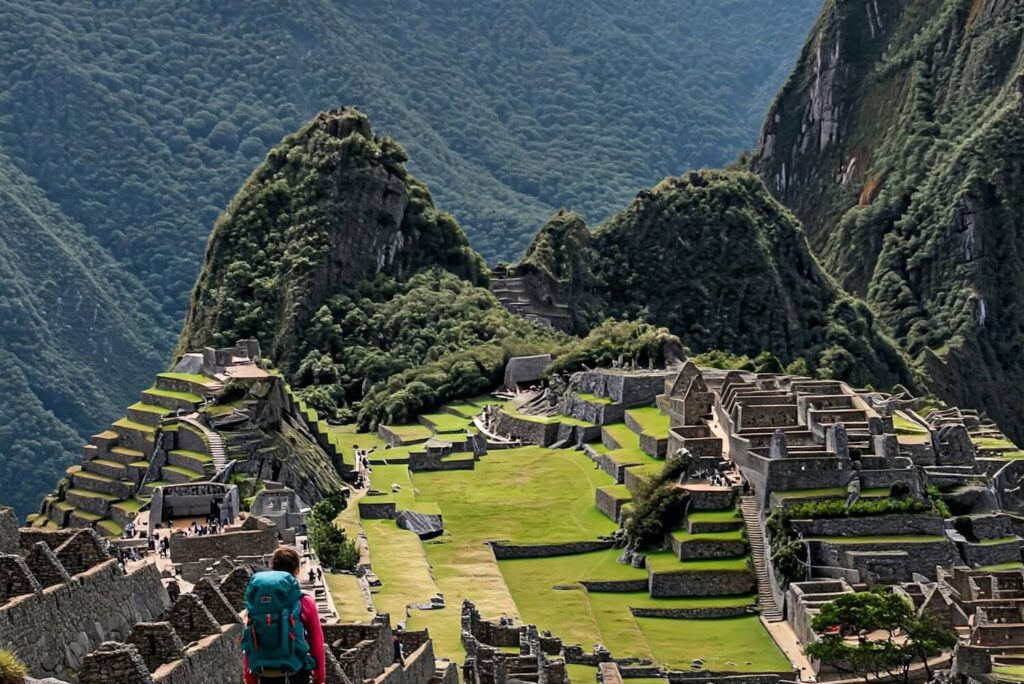Introduction to the Inca Trail
The Inca Trail stands as one of the most iconic trekking routes in the world, revered not just for its stunning landscapes but also for its rich historical significance. This renowned trail leads adventurers through the breathtaking Peruvian Andes, ultimately culminating at the ancient site of Machu Picchu—one of the New Seven Wonders of the World. The journey along the Inca Trail offers a unique glimpse into the once-thriving Inca civilization, with numerous archaeological sites dotting the landscape. Hikers traverse ancient pathways constructed by the Incas, allowing them to connect with history while experiencing the natural beauty of the region.
Attracting thousands of trekkers each year, the allure of Machu Picchu is undeniable. The site is not only a testament to Inca engineering and architectural prowess but also a symbol of cultural heritage revered globally. As hikers walk through various ecosystems, ranging from high-altitude deserts to lush cloud forests, the diversity of flora and fauna adds an extra layer of charm to the expedition. The varied terrain, combined with the changing weather, presents a challenge that many adventurers find invigorating.
Embarking on the Inca Trail requires careful preparation, as the trek typically spans four days and covers approximately 26 miles. Each phase of the trek offers distinct experiences, from challenging ascents to serene valleys. Aspiring trekkers are often lured by dreams of witnessing the sun rise over Machu Picchu, a transformative moment that encapsulates the essence of this journey. The combination of physical challenge, cultural immersion, and breathtaking scenery make hiking the Inca Trail a once-in-a-lifetime experience for many. As participants navigate through both the natural splendor and historical landmarks, they create memories that resonate long after the adventure concludes.
Preparing for the Hike
Embarking on the Inca Trail requires careful preparation to ensure a safe and enjoyable experience. Physical training is paramount, as the trail is challenging and demands good cardiovascular endurance, strength, and flexibility. Begin a training regimen at least a few months before your hike, incorporating activities such as hiking, jogging, cycling, or swimming to build stamina. Additionally, consider practicing on uneven terrain to simulate the conditions of the Inca Trail.
Equipping yourself with the right gear is essential for a successful trek. A comfortable pair of hiking boots is vital, as they will provide necessary support and protection for your feet over long distances. Moisture-wicking clothing, a weather-resistant jacket, and a good-quality backpack are also principal components of your hiking gear. Make sure to pack lightweight essentials such as a sleeping bag, first-aid kit, and portable water filtration system to ensure you have what you need without carrying excessive weight.
Moreover, obtaining the necessary permits is a crucial step in preparing for your hike. Permits for the Inca Trail are limited and often sell out months in advance, requiring early planning. Consider whether you prefer a guided tour or an independent trek. Guided tours can simplify logistics and provide valuable insights into the trail’s history and ecology, while trekking independently offers a more solitary experience in nature.
Acclimatization to the altitude is another critical factor in your preparation. Plan to arrive in Cusco a few days before your trek to allow your body to adjust to higher elevations, reducing the risk of altitude sickness. Consuming plenty of water, avoiding alcohol, and allowing your body to rest will aid the acclimatization process. By carefully preparing, you can enhance your Inca Trail experience and prepare for the adventure that lies ahead.
Navigating the Inca Trail Route
The Inca Trail is a remarkable journey that spans approximately 26 miles (42 kilometers) and typically takes four days to complete, culminating at the breathtaking site of Machu Picchu. Each day on the trail presents unique challenges and stunning vistas, making it an unforgettable trekking experience. The route not only varies in distance and elevation but also traverses diverse ecosystems that reflect the rich biodiversity of the Andean region.
On the first day, hikers will cover approximately 7.8 kilometers (4.8 miles) as they ascend gradually to an elevation of about 2,600 meters (8,530 feet). This leg of the journey meanders through lush vegetation and offers glimpses of the vibrant flora and fauna. As you walk through the cloud forest, keep an eye out for the unique bird species and native plants that inhabit this rich ecosystem.
The second day on the Inca Trail is recognized as the most challenging, as it includes the steep ascent to Dead Woman’s Pass, which is the highest point on the trek at 4,215 meters (13,828 feet). Covering approximately 11 kilometers (6.8 miles), hikers will experience significant elevation changes and breathtaking panoramas. As you navigate this strenuous section, the change in ecosystems becomes evident, transitioning from cloud forest to alpine tundra. The breathtaking views from Dead Woman’s Pass reward those who conquer this challenging segment.
On the third day, the trail descends and flattens out somewhat, as hikers travel around 15 kilometers (9.3 miles) and experience the rich archaeological sites such as Runkurakay and Sayacmarca. This leg provides a refreshing contrast to the previous day’s efforts while still offering remarkable views of the Andes with diverse ecosystems. The final day is a short but memorable 6 kilometers (3.7 miles), leading hikers to the Sun Gate (Inti Punku) for a stunning view of Machu Picchu at sunrise. This last stretch signifies the successful completion of the awe-inspiring Inca Trail adventure.
Daily Itinerary: What to Expect
Hiking the Inca Trail to Machu Picchu is often a multi-day expedition, typically spanning four days. Each day presents unique challenges and awe-inspiring views, creating an unforgettable journey through the Andean landscape.
On the first day, hikers typically meet at a designated location in Cusco. After a briefing, the group will travel to the starting point at Km 82. The first day’s trek generally involves a moderate hike lasting approximately five to six hours, traversing along the Urubamba River, and offering stunning views of the surrounding mountains. Lunch is usually provided en route, and hikers will camp at a designated site, such as Ayapata, where dinner will be served amidst stunning vistas.
Day two is often regarded as the most challenging. Hikers will ascend to the highest point of the trail, Dead Woman’s Pass, at an altitude of 4,215 meters (13,828 feet). This trek can take around six to eight hours, combined with breathtaking views of valleys and peaks. After reaching the top, the descent toward the next campsite at Pacaymayo awaits, where warm meals and camaraderie can provide much-needed comfort after a strenuous day.
The third day tends to be less physically demanding but rich in cultural significance. Trekkers visit numerous archaeological sites such as Runkuraqay and Sayacmarca along the route. The hike usually lasts about five to six hours, leading to the campsite at Wiñay Wayna, nestled close to Machu Picchu. This site provides a final taste of the stunning views that await.
The final day comprises an early morning trek to the Sun Gate (Inti Punku), culminating in the breathtaking arrival at Machu Picchu. Hikers often spend the day exploring the ruins, absorbing the history and magnificence of this ancient city, before descending to Aguas Calientes for a well-deserved rest. This itinerary captures the spirit of adventure on the Inca Trail, blending physical challenge with unparalleled beauty and cultural heritage.
Encountering the Incan Heritage
The Inca Trail is not just a physical journey; it serves as a profound connection to the rich cultural history of the Inca civilization. As hikers traverse this celebrated route, they are continuously surrounded by remarkable archaeological sites that reveal the historical significance and ingenuity of the Incas. Each step taken along the trail offers an opportunity to explore the remnants of structures that have stood the test of time, showcasing the sophistication of this ancient culture.
One of the most notable sites encountered is Wiñay Wayna, which translates to “forever young.” This breathtaking ruin features terraced agriculture, religious sites, and an intricate water fountain, all indicative of the Incas’ advanced understanding of engineering and agriculture. The site not only provided sustenance to the Inca people but also served as a crucial waystation for travelers on the Inca Trail, nurturing their spirituality and communal identity.
Beyond Wiñay Wayna, trekkers will also encounter Phuyupatamarca, known as the “Place Above the Clouds.” This archaeological marvel boasts a well-preserved complex of buildings and extensive terracing, illustrating the Incan expertise in adaptation to varied altitudes. The spiritual essence of the site can be felt profoundly, as it offers sweeping views of the surrounding mountains, inspiring a sense of awe similar to what ancient worshippers might have experienced.
Moreover, the Incas imbued their landscape with deep spiritual significance, often aligning their architecture with celestial bodies and natural landscapes. This connection to the earth and sky is evident in the construction of sacred sites like Intipunku, the Sun Gate, which marks the entrance to Machu Picchu. This location symbolizes the culmination of a journey not only through nature but also through time, linking modern-day hikers to the past in a meaningful way.
Through these encounters along the Inca Trail, hikers not only appreciate the beauty of nature but also gain insight into the traditions, spirituality, and customs that defined Incan life. This journey fosters an understanding of the profound legacy left behind by this remarkable civilization, highlighting the need to preserve and respect these world heritage sites.
Dealing with Challenges on the Trail
Hiking the Inca Trail to Machu Picchu is a dream for many, yet the journey is not without its challenges. One significant aspect hikers need to prepare for is altitude sickness, which can affect anyone regardless of their fitness level. The Inca Trail reaches elevations of over 4,200 meters (13,800 feet), making acclimatization essential. To minimize the risk, it is advisable to spend a few days in Cusco or other high-altitude locations before starting the trek. Staying hydrated and consuming high-carbohydrate meals can also help the body adjust more effectively.
Weather conditions are another factor that hikers need to consider. The trail passes through diverse ecosystems, resulting in varying weather patterns. Trekkers often face unexpected rain, intense sun, or chilly temperatures, especially in the early morning and at night. It is crucial to equip oneself with layered clothing that can be easily adjusted, as well as waterproof gear to stay dry during unexpected downpours. Understanding the seasonality of the region can aid in planning the trek during the most favorable weather months, which typically run from May to September.
Physical fatigue is a common hurdle encountered along the Inca Trail. The trek covers approximately 43 kilometers (26 miles) over four days, with several steep ascents and descents. To prevent exhaustion, it is recommended to engage in physical training prior to the hike, which may include cardio workouts, strength training, and longer hikes similar in terrain. Establishing a steady pace while walking and taking periodic breaks can also significantly mitigate fatigue. Listening to one’s body is vital; hikers should not hesitate to recognize when they need to rest or seek assistance.
Cultural and Natural Highlights
The Inca Trail presents an exceptional blend of natural beauty and rich cultural heritage that significantly enhances the trekking experience. As hikers progress along this historic pathway, they are greeted by breathtaking panoramas showcasing the majestic Andes Mountains, lush valleys, and pulsating rivers that characterize this part of Peru. The diverse ecosystems encountered along the trail play host to an array of unique flora and fauna. Charming orchids, vibrant bromeliads, and towering ferns create a vivid tapestry of colors while the occasional sighting of indigenous wildlife, such as the elusive Andean condor or the playful road runner-like bird, can elevate the trekking experience further.
Cultural interaction is another vital component of the Inca Trail adventure. Along the route, trekkers will encounter local communities that retain their traditional lifestyles, which are deeply intertwined with the cultural identity of the region. These communities often engage trekkers in traditional customs and practices, offering glimpses into their daily lives and age-old rituals. For instance, visitors may witness a local family performing a sacred Pachamama (Mother Earth) ceremony, reflecting the deep respect these people hold for nature. Sharing a meal prepared using locally sourced ingredients further amplifies the connection between the hiker and the culture of the land.
Moreover, the historical significance of the Inca Trail cannot be overstated. As hikers approach the famed ruins of Machu Picchu, the culmination of their journey becomes more than just a physical challenge; it transforms into a spiritual odyssey enriched by the stories of the ancient Incan civilization. Walking the same path as the Incas inspires awe, as one contemplates the intertwining aspects of nature and culture that define this remarkable trek. From stunning landscapes to the warmth of local encounters, the Inca Trail is a gateway to understanding the ecological and cultural fabric of the region.
Reaching Machu Picchu
Arriving at Machu Picchu is an unforgettable experience that captivates the hearts of hikers from around the globe. As adventurers reach the sun gate, known as Inti Punku, the breathtaking view of the ancient ruins nestled between majestic mountains often evokes a sense of awe and accomplishment. Many hikers describe the moment as spiritually uplifting, marking the culmination of their journey along the Inca Trail.
To fully appreciate this iconic site, it is advisable to take a few moments to absorb the surrounding landscape. The interplay of light and shadow at different times of the day paints a unique picture, making early morning visits particularly enchanting. Additionally, capturing the perfect photograph is simplified by heading to popular viewpoints like the classic vantage point near the entrance and capturing the entrance from above, where the mystical aura of the ruins is amplified.
When exploring Machu Picchu, it is essential to engage with the historical context of the site. Guided tours often provide a wealth of information regarding its significance as a central location for the Inca Empire and its intricate architecture. Essential spots within the ruins include the Temple of the Sun and the Intihuatana stone, often regarded as a ritualistic centerpiece. Hikers should aim to balance exploration with moments of reflection, allowing the history and spirit of the location to resonate deeply.
Additionally, for those wishing to avoid the crowds, visiting during off-peak hours can enhance the experience. Consider spending a little time at less frequented areas within Machu Picchu, where one can relish the serene atmosphere and picturesque settings. This journey concludes not just with the physical achievement of reaching a destination, but with a profound emotional connection to the legacy of the Incas and the stunning beauty of the Andean landscape.
Post-Hike Reflections and Tips
Completing the Inca Trail is not just a physical accomplishment; it’s also an emotional and mental journey. As you reflect on your experience, take time to journal your thoughts and feelings. Writing about your encounters along the trail, the breathtaking views, and the camaraderie shared with fellow hikers can offer a deeper understanding of the transformation that accompanies such an adventure. Documenting your experiences allows for introspective insights and can become a cherished keepsake to revisit in the future.
Once you have returned to Cusco, consider engaging in post-hike activities that allow you to further explore and appreciate the rich cultural heritage of the region. Visiting local markets, taking cooking classes, or participating in traditional ceremonies can enhance your experience and connection to the area. These activities provide opportunities to unwind after the physical exertion of the trek while offering a richer understanding of the local culture and customs.
Additionally, think about planning future adventures, either along similar trails or new destinations altogether. Each hike can bring new challenges and rewards, fostering not only physical fitness but also personal growth. Whether you choose to explore the Sacred Valley, embark on another iconic trek, or try something completely different, there are countless paths waiting to be discovered.
The transformational nature of hiking the Inca Trail should not be understated. It is a rite of passage that encourages reflection, growth, and sharing of stories with others. By sharing your experiences, you may inspire someone else to embark on their own adventure. Therefore, consider discussing your journey with friends, family, or fellow trekkers, fostering a community of shared experiences and inspiration for future endeavors. Each story contributes to the rich tapestry of adventure and exploration that defines trekking in this remarkable region.



